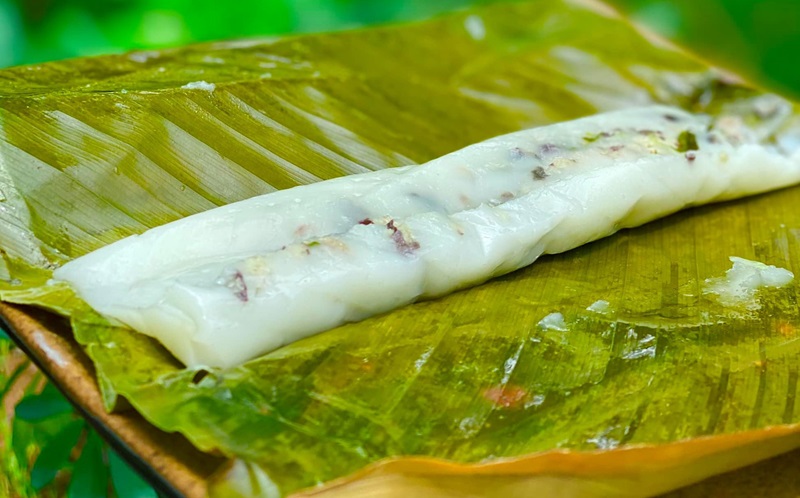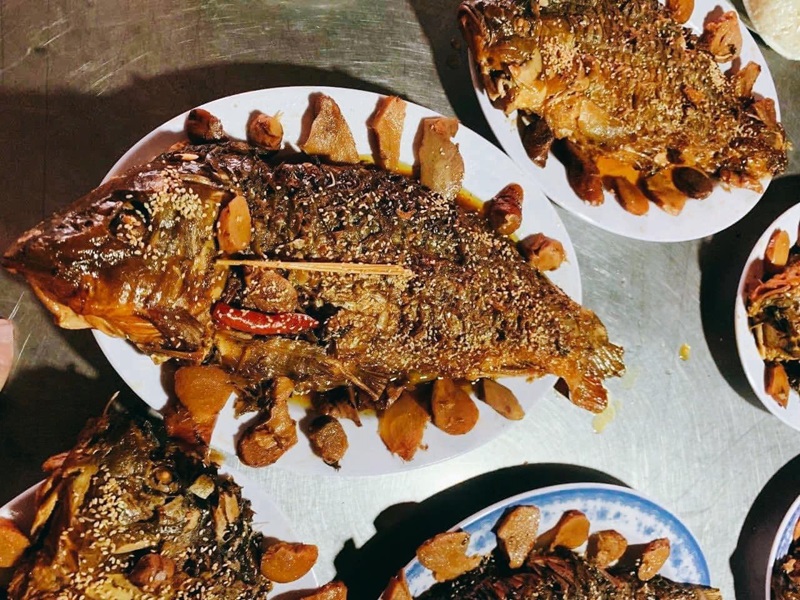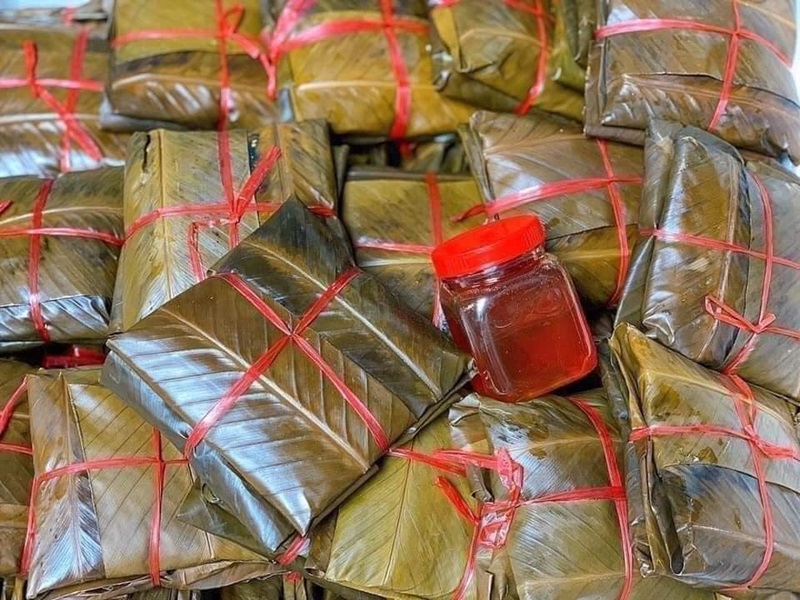Dan Phuong District: Each village, one culinary specialty
The famous century-old dishes of Hanoi's countryside conquer the hearts of diners.
Dan Phuong is located in the sacred land of Xu Doai (one of the four ancient provinces surrounding Thang Long), home to talented people, rich history and cultural traditions.
Each village in the district has its own signature cuisine that embodies the essence of local cultural charms, such as Phung Town pork skin salad, Hong Ha tofu and rice wine, Lien Ha steamed rice cake, Lien Hong plain pyramid rice dumpling, or Ha Mo kneaded congee.
Unique countryside dishes
| Banh te or rice dumplings - a specialty of the Dan Phuong district. Photo: Le Phuong |
Originally a fishing village on the Day River, Tho Vuc Village in Dong Thap Commune is home to a special fish stew technique. The dish is made only by male villagers and requires meticulous preparation. After washing the fish, the guts are removed while the scales are left on. The whole fish is then placed in a large pot.
Tho Vuc Village braises the fish with split sugarcane, thinly sliced galangal root, fermented soybean paste, thickened vinegar, wet caramel, pepper, and just enough water. To keep the fish from sticking together and breaking when removed, layers of fish are separated with layers of bamboo wattle and thinly sliced sugarcane.
"Fish must be braised twice to be tasty. The first time, we usually braise them for about four hours and then let them cool. For the second braising, we take out all the layers of fish and put them back in the pot in reverse order, then boil them for about three hours. This way, the fish is cooked evenly and absorbs the spices, while the bones become crumbly and soft," said Vinh Chien, a villager from Tho Vuc.
The braised fish hero is accompanied by delicious steamed rice, formed into chunks about eight centimeters wide and 15 centimeters long. A fish served with steamed rice must be whole, with its scales and fins intact and its tail an appetizing dark yellow.
| Tho Vuc braised fish dish. Photo: Dan Phuong Que Toi |
On a par with " Braised Fish and Molded Steamed Rice" from Tho Vuc Village, banh gio or simple pyramid rice dumplings, is another work of art from the Dan Phuong people.
According to Tran Thi Thao, a villager from Thuong Tri Village, Lien Hong Commune, the ingredients of banh gio are sticky rice and ash water, with la dong or Stachyphrynium placentarium leaves and bamboo strings for wrapping. Among them, the ash water is an important factor that determines the quality of the cake.
People in different localities have their own secret recipe for ash water. In Thuong Tri village, the water is made from natural plants such as spiny amaranth, sesame or soybean. These plants are dried, burned to produce ash, and then soaked in water with a little lime for about 30 days.
When the ash settles, the clear water is used to soak sticky rice before portions of the rice are wrapped in la dong. After cooking, banh gio is served cold with fragrant dark brown molasses. It's an indispensable dish on the Tet tray of the people of Lien Hong Commune in particular and a favorite dish of every Dan Phuong resident.
Meanwhile, Ha Mo Commune is proud of its chao se or kneaded congee, which is characterized by a strange, memorable way of eating. While in many places, the porridge is eaten with a spoon, in Ha Mo Village, diners must use chopsticks to enjoy the congee.
| A Dan Phuong's specialty- the squared banh gio. Photo: Mai Phuong |
According to Nguyen Xuan Viet, Ha Mo commune's cultural officer, the ingredients for chao se are quite simple, usually just non-glutinous rice and pork bones. However, the cook must take several meticulous steps. After being thoroughly washed, selected non-glutinous rice is soaked in water for about 12 hours until soft, then ground into wet flour. This flour is then placed in a cloth bag to filter out the water, leaving a smooth white dough.
The broth can be made by simmering any pork bone, but the tail is the tastiest, slightly sweet but not greasy. When the broth is ready, the cook takes each small piece of dough in the palm of his hand, kneads it into a string the size of a chopstick tip, and drops it into the pot of boiling broth.
This step is quite time-consuming, so it is often done by two or three people together. In the boiling water, the well-kneaded strings of dough cook quickly without sticking together. From time to time, the cook uses long chopsticks to gently stir the broth, breaking the strips into bite-sized pieces.
In addition to the three dishes mentioned above, the Dan Phuong people offer various delicacies, namely banh te or rice dumplings from Lien Ha and Dan Phuong communes, nem Phung or Phung Town pig skin salad, Hong Ha tofu, or Song Phuong peanut candy. Many of these have found their way into Hanoi folk songs:
“Chem pork bologna, Ba wine, nem Phung
Anyone who hasn't enjoyed them yet,
please don't brag about fancy eating...”
| Chao se or kneaded congee dish from Ha Mo Village, Dan Phuong District, Hanoi. Photo: Vietsense Travel |
Honoring local cuisine
According to Vinh Chien from Tho Vuc Village, the combo of stewed fish and steamed rice originates in the Ky Phuc Festival in Tho Vuc fishing village.
Every year, the village holds two festival days: one on the 10th day of the third lunar month, and the Ky Phuc Festival or "Rice and Fish Feast" on the 19th and 20th days of the eighth lunar month to pray for abundant shrimp and fish from the river and good harvests.
About 10 days before the festival, Tho Vuc villagers usually go fishing for big carp. With offerings composed of precious agricultural and aquatic products, their "rice and fish feast" is a unique spiritual beauty that has been maintained for centuries.
As for Lien Hong Commune, banh gio is associated with a very special fair in Thuong Tri village. Every year on the 27th day of the 12th lunar month - when the last fair of the year is held - the married women of Thuong Tri come back to the village fair to buy chao se (kneaded congee) and banh gio as gifts for their parents. This is also a traditional dish and gift during Tet (Lunar New Year) that Thuong Tri people give to relatives far away.
Dan Phuong is an ancient land with many historical and cultural beauties. The "Festival of Agricultural Products - Culture - Cuisine - Tourism in Dan Phuong District 2023", which will be held from November 16 to 19, is an opportunity for the district to promote its unique cultural and culinary features, display and introduce OCOP products, ornamental animals, agriculture, cottage industries and typical handicraft villages of the district. Especially for the cuisine, this is an opportunity for Dan Phuong to disseminate delicious dishes by serving locals and visitors.
| The dish of nem Phung or pork skin salad from Phung Town, Dan Phuong District. Photo: Mai Phuong |




.jpeg)











